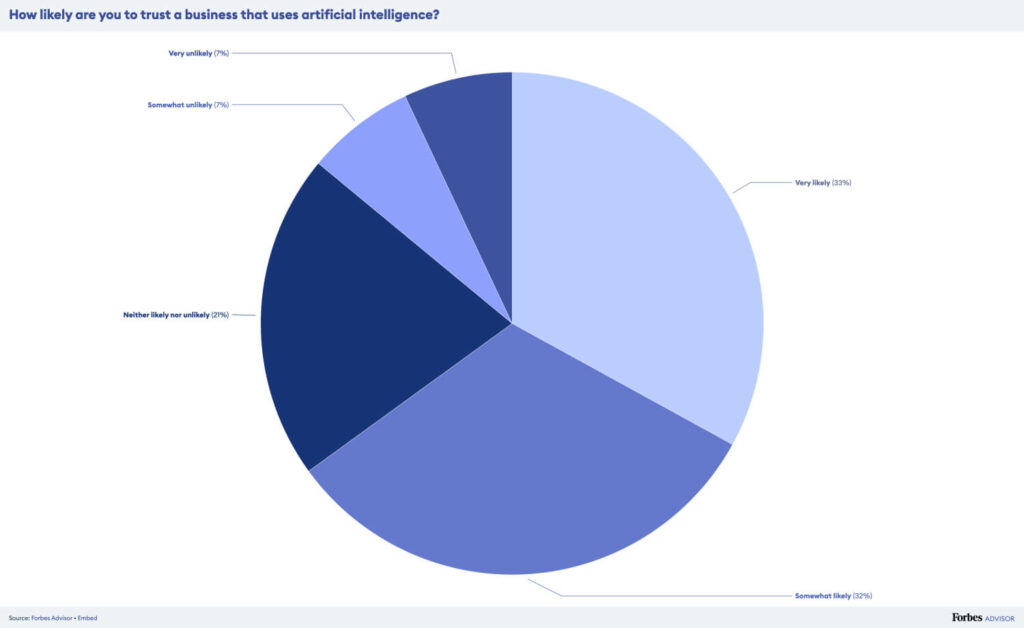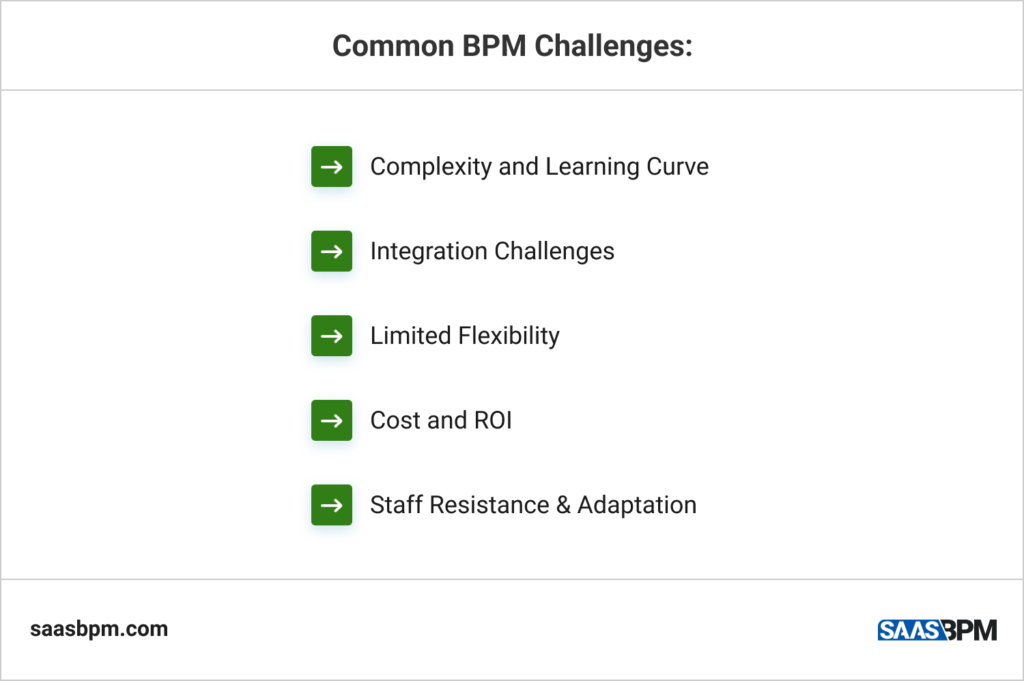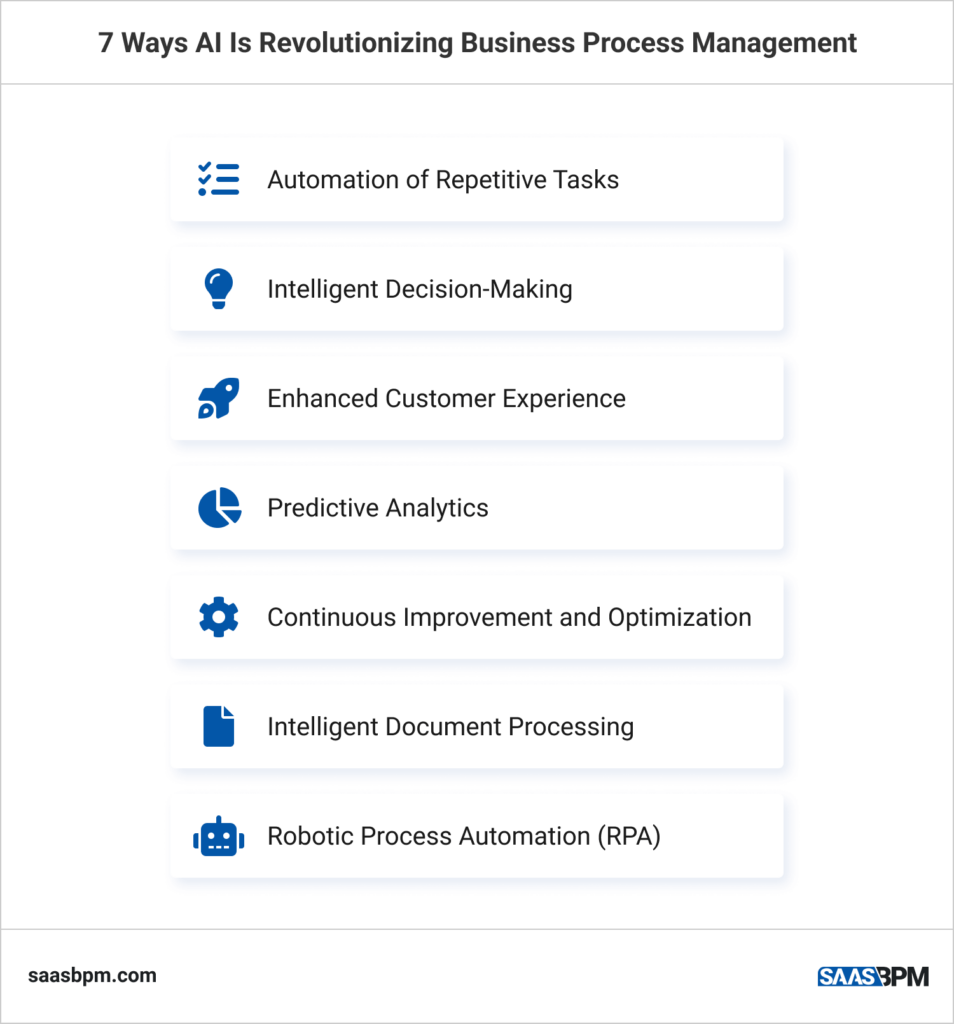Artificial Intelligence (AI) has become a transformative force in various industries, and its impact on business process management is undeniable. By automating tasks, analyzing data, and making intelligent decisions, AI for business processes is revolutionizing the way organizations streamline operations, improve efficiency, and drive growth.
With AI technologies such as machine learning, natural language processing, and robotic process automation, businesses can automate repetitive tasks, extract valuable insights from data, and make data-driven decisions. This empowers organizations to optimize workflows, reduce costs, and enhance productivity in their BPM strategies.
Despite the stigma associated with automation in the workplace, AI is on the rise to further enhance our productivity and business offerings. 77% of employees fear AI will take over their job. At the same time, over 60% of business owners believe AI will improve productivity. It seems that no matter if you implement automation tools in your business ops or not, customers are relatively unbiased about it:

In this article, we will discuss some of the key limitations of BPM, and how AI for business processes can help.
What Are The Limitations of Business Process Management Software?

Business process management is not a new concept at all. ‘Division of labour’ (which is the essence of the organization of workplace operations) was talked about as early as the 18th century by Adam Smith in his “Wealth of Nations”. However, to this day, there are still some challenges at managing tasks effectively.
Complexity and Learning Curve
Implementing BPM often involves a steep learning curve. The complexity of configuring and customizing the software to align with specific business processes can be challenging. It may require specialized skills and expertise to set up and maintain the system effectively. Organizations need to allocate sufficient time and resources for training employees to ensure a smooth transition and maximize the software’s potential.
Integration Challenges
Compatibility issues may arise when connecting the software with legacy systems or different technology platforms. Ensuring seamless data flow between systems and maintaining data integrity may require additional development efforts and resources.
Lack of Flexibility
While BPM software offers automation and standardization, it can sometimes limit the flexibility and agility required in rapidly changing business environments. Once processes are defined and automated within the BPM software, making changes or introducing new workflows can be time-consuming and require significant effort. This lack of flexibility may hinder organizations’ ability to quickly adapt to evolving needs or market conditions.
Cost and Return on Investment (ROI)
Although usually quite cheap, implementing and maintaining BPM software can sometimes involve substantial costs in the long run, including software licenses, customization, training, and ongoing support. SMEs with limited budgets may find it challenging to invest in BPM software solutions. Additionally, achieving a positive return on investment may take time, as organizations need to realize the full potential of the software through process optimization and efficiency gains.
Human Factors
While BPM software can automate and streamline processes, it is crucial to consider the human element. Resistance to change or a lack of user adoption can undermine the success of BPM initiatives. Employees may need to adapt to new workflows, interface designs, or reporting structures, which can cause initial disruptions and resistance. Proactive change management and effective communication are essential to address these human factors and ensure successful adoption of BPM software.
7 Ways AI Is Revolutionizing Business Process Management
AI has emerged as a game-changer in various industries, and its impact on project management is revolutionary. Let’s explore the key ways in which AI is transforming BPM.

1. Automation of Repetitive Tasks
AI for business processes enables the automation of repetitive and mundane tasks, freeing up valuable human resources to focus on more strategic and complex activities. Machine learning algorithms can analyze historical data, learn from patterns, and automate routine tasks with speed and accuracy. This automation not only improves efficiency but also reduces the chances of errors, leading to higher productivity and cost savings.
2. Intelligent Decision-Making
AI-powered BPM systems can make intelligent decisions by analyzing vast amounts of data. Machine learning algorithms can identify trends, predict outcomes, and provide valuable insights to ease decision making. This empowers organizations to make data-driven decisions, optimize processes, and improve overall business performance.
3. Enhanced Customer Experience
AI technologies, such as natural language processing and sentiment analysis, enable organizations to better understand customer interactions and sentiment. AI-powered chatbots and virtual assistants can provide personalized and real-time support to customers, enhancing the overall customer experience. By analyzing customer data, AI can also help organizations identify patterns and trends to proactively address customer needs and preferences.
4. Predictive Analytics
AI algorithms can analyze historical data and identify patterns and correlations that humans may overlook. This enables organizations to leverage predictive analytics in BPM, anticipating future trends, demand, and potential bottlenecks. By identifying potential issues in advance, organizations can take proactive measures to mitigate risks, optimize processes, and ensure smooth operations.
5. Continuous Improvement and Optimization
AI for business processes enables organizations to continuously monitor and optimize their workflows. By analyzing real-time data and performance metrics, AI algorithms can identify inefficiencies, bottlenecks, or areas for improvement. This feedback loop helps organizations refine their processes, eliminate waste, and enhance overall operational efficiency.
6. Intelligent Document Processing
Traditional document processing and management can be time-consuming and error-prone. AI technologies, such as optical character recognition (OCR) and natural language processing, can automate document extraction, classification, and indexing. This significantly speeds up document processing, reduces manual effort, and improves data accuracy.
7. Robotic Process Automation (RPA)
RPA, combined with AI, is revolutionizing BPM by automating complex tasks that previously required human intervention. AI-powered bots can interact with systems, process unstructured data, and perform rule-based tasks, replicating human actions. This reduces manual errors, accelerates processes, and improves overall operational efficiency.
How To Optimize Processes with ChatGPT
ChatGPT, powered by advanced natural language processing and machine learning, offers a unique opportunity to optimize business processes and enhance operational efficiency. Here are a few ideas:
- Automated Customer Support. ChatGPT can be trained to handle customer queries and provide automated support. By utilizing historical customer interactions and training the model with relevant data, you can create a chatbot that can effectively respond to customer inquiries, provide information, and resolve common issues. This helps to reduce response times, enhance customer satisfaction, and free up human resources for more complex tasks.
- Personalized Recommendations. Leverage ChatGPT to provide personalized recommendations to customers. By analyzing customer data, browsing history, and preferences, the model can suggest products or services tailored to each individual. This level of personalization enhances the customer experience, increases engagement, and drives sales.
- Process Automation. ChatGPT can be integrated into existing business systems to automate repetitive tasks. For instance, it can generate automated responses to common email inquiries, assist with data entry, or perform basic administrative tasks. This saves time, reduces errors, and allows employees to focus on higher-value activities.
- Enhanced Decision-Making. Utilize ChatGPT’s analytical capabilities to support decision-making processes. The model can analyze data, extract insights, and provide recommendations based on the input received. This helps businesses make informed decisions faster, optimize resource allocation, and improve overall efficiency.
- Continuous Improvement. As ChatGPT interacts with customers and processes data, it gathers valuable information that can be used for continuous process improvement. By analyzing the conversations, identifying trends, and gathering feedback, organizations can identify pain points, optimize workflows, and enhance the overall customer experience.
Conclusion
AI causes a lot of hype about taking over job roles and insufficiency, but it can indeed enhance productivity in the workplace if used correctly. Keep in mind the most common challenges businesses face when implementing automation, and harness the power of AI to improve your business processes and boost your success!

